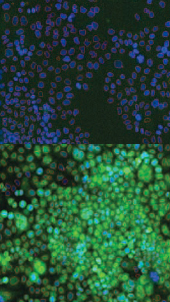
In recent years, synthetic small interfering RNAs (siRNAs) have emerged as a promising therapeutic approach. These molecules can inhibit gene expression by turning off the activity of disease-causing genes to produce a therapeutic benefit. However, the delivery of these siRNAs to their site of activity in a living organism is a complex multi-step process that continues to be optimized. Among the different delivery strategies, lipid nanoparticles are one of the most advanced technologies currently being used in human clinical trials. Researchers at the MPI-CBG and Alnylam Pharmaceuticals were interested in identifying the molecular mechanisms that are involved in the process when cells internalize lipid nanoparticles.
First, researchers monitored the uptake of lipid nanoparticles loaded with traceable siRNAs in different cell types in cell culture in vitro, but more importantly, in mouse liver tissue in vivo. To do so, they used quantitative fluorescence imaging and electron microscopy. This approach revealed that lipid nanoparticles enter cells by two different routes in a cell type-specific manner. This important finding explains why all cells are not equally competent for internalizing lipid nanoparticles efficiently and rapidly. Moreover, the Dresden research team headed by Marino Zerial, director and research group leader at the Max Planck Institute of Molecular Cell Biology and Genetics (MPI-CBG), discovered that, once entered into a specialized (endosomal) compartment in the cell, the siRNAs had a limited time window to reach their site of function, escaping destruction in the lysosomes. Although the mechanism leading to the formation of this compartment is still unknown, it is clear that it could be important for efficient siRNA delivery.
These data could have important implications for the development of new strategies to further improve the delivery of RNAi therapeutics. The recent work revealed that though lipid nanoparticles are a very efficient delivery system in vivo, a large fraction of the siRNAs is still degraded within the lysosomes – the stomach of the cell where components are degraded. Therefore, careful selection of nanoparticle components to enhance endosomal release will be a successful strategy to improve the potency of future RNAi therapeutics.
Jerome Gilleron, William Querbes, Anja Zeigerer, Anna Borodovsky, Giovanni Marsico, Undine Schubert, Kevin Manygoats, Sarah Seifert, Cordula Andree, Martin Stöter, Hila Epstein-Barash, Ligang Zhang, Victor Koteliansky, Kevin Fitzgerald, Eugenio Fava, Marc Bickle, Yannis Kalaidzidis, Akin Akinc, Martin Maier & Marino Zerial:
Image-based analysis of lipid nanoparticle–mediated siRNA delivery, intracellular trafficking and endosomal escape
Nature Biotechnology (2013), doi:10.1038/nbt.2612